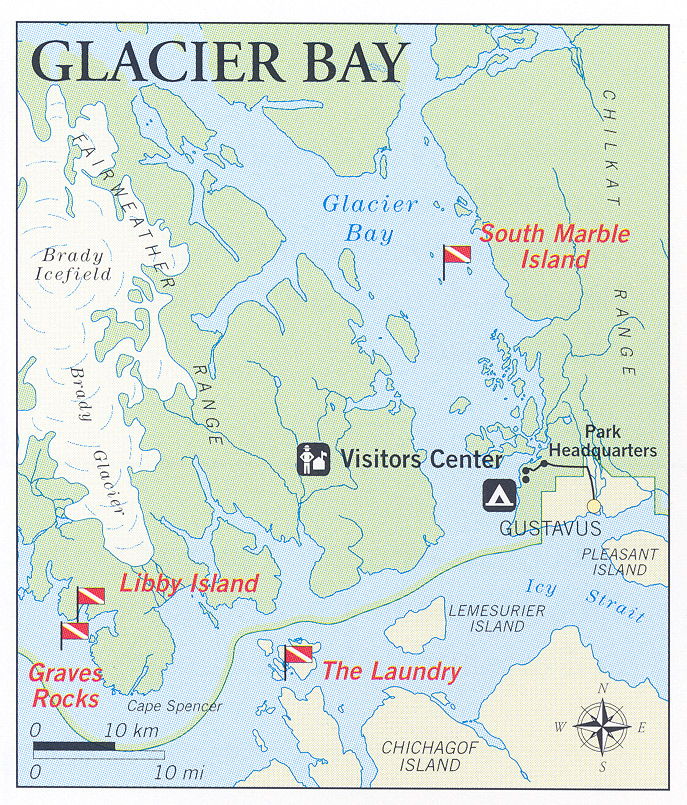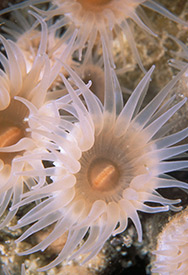Diving in Glacier Bay National Park
Many authors have about the awesome landscapes in Alaska’s Glacier Bay, and they are indeed breathtaking. So, in its own way, is the underwater environment. Glacier Bay is in constant motion. The geological forces of the glaciers, the sea, and the earth are still involved with the business of creation. Standing among these great forces, you feel as though you are standing on the threshold of time itself.
With some careful observation, it is possible to witness the evolution of this landscape from day to day. The experience is much like watching a skilled artist produce a beautiful painting over the course of a few days. The word "wilderness" evokes images of abundant wildlife, wide open spaces, and biological diversity. Each of these is exemplified and embodied at Glacier Bay Park and Preserve which includes active glaciers, old growth spruce forests, vast alpine meadows, and a marine environment that is among the most diverse and productive on earth.
The bay is located at the northern end of Alaska's panhandle-that long strip of islands, channel, and narrow coastal strip that runs between the North Pacific and the coast of British Columbia.
BASICS
Location: Alaska Panhandle
Skill level: Intermediate-advanced
Access: Boat
Dive support: Juneau
Best time of year: Mid-May, June, September through October
Visibility: Poor to excellent (up to 70 feet)
Highlights: Abundant marine life
Concerns: Extreme cold, ocean currents, whales
Rules and Regulations
Dive Site Map

Dive Overview
Unless you have your own ocean-going vessel equipped for diving, you have to really want to dive to make it happen in this place. Is it worth it? Yes! Absolutely. But diving at Glacier Bay presents some serious challenges. The first is just getting there. It must be by boat or plane because there are no roads to Glacier Bay. The second challenge is obtaining diving support. There are no commercially available air compressors in Glacier Bay. Commercial jets fly into Gustavus only during the summer months. Any other time, the closest you can get is Juneau and then you have to charter a bush plane to take you the rest of the way. With the amount of support gear it would take to support a week-long dive trip, you might need a whole flock of bush planes to get you and your gear to Glacier Bay. Once there, you would have to talk a local fishing-boat operator into taking you diving, competing for their services against such high bidders as the commercial fishing industry and sport fisherman who hire them as guides. Probably the best bet would be to try and organize a charter through a dive shop in Juneau. Yes, there is at least one dive shop in Juneau. At least there is as of this writing.
If you overcome all these obstacles and make it up to Glacier Bay with your gear, an air source, and good local knowledge, you will not be disappointed. The diving conditions are highly variable in terms of water visibility and dive skills required. In general, the diving is for those experienced in cold water and current diving. As in the other areas of the Northwest, there are extreme tidal fluctuations which, when brought in contact with long bays, islands, and a very irregular coastline, produce some raging currents. The water temperature is rarely above the high 40°F and in many areas it is not unusual to be diving in the mid and upper 30s.
Water visibility is dependent on both the time of year and the location. Because the areas waters are so rich, in the summer, when days are longer-20 hours or so-and the water gets more sun, the algae starts to bloom, reducing visibility in some cases to less than 10 feet. The bays and inside waters are most affected by these algae blooms; the outer coast less affected. The winter has the best visibility but a host of other problems to deal with, not the least of which is brutal air temperatures. That leaves May through mid-June and then September and October as the best times to be diving here.
Here are thousands of bays, islands, inlets, and, near them, sea mounts, kelp forests, wall dives, drift dives, game taking dives, or photography dives. Alaska has it all. Diving this park could easily be the subject of a whole book, but with so little space and such a vast subject, we will give you just a few site descriptions to wet your appetite.
Dive Sites
THE LAUNDRY
This is a wild drift dive. The degree of wildness depends on the state of the tide when you dive it and whether you want to cruise a beautiful wall at warp speed or at a more leisurely pace. The site got its name because the current rips though here so powerfully at times that anyone in it feels as if they're being tossed around in a washing machine. The dive site is a narrow channel between two islands that sit southwest of Indian Island between South Indian Pass and North Indian Pass. The wall is along the west side of the cut. The depths along the wall range from 35 feet to about 75 feet. It is a good area for seeing nudibranchs, basket starfish, and anemones. The wall is also very colorful, covered as it is with pink coralline algae. This would be a good place for pictures if you could stay in one place long enough or if you are good at shooting on the fly.
LIBBY ISLAND
This is an outer-coast, kelp-forest dive. Libby Island is a small island just north of Cross Sound, and the best site is along the east side of the island. Here the water depth drops off rapidly very close to shore. The dive starts in about 25 feet of heavy kelp. The bottom stair-steps down in a series of small walls to just over 70 feet. The area is loaded with rockfish that stack themselves up in layers throughout the kelp. The heavy concentrations of invertebrate life decorating the rocks and the dense kelp forest make it a good site for photography, either macro or wide angle. Large halibut may be encountered below the reef out in the sand.
GRAVES ROCKS
This site is just south of Libby Island and out toward the open ocean, where several rock islands break the surface. Each has a nice kelp forest apron around it. The best depths are from 30 to 70 feet. Beyond 70 feet is a sand bottom, but above that depth is a beautiful reef made up of large rock ledges with some deep gorges. There are crowds of rockfish in the kelp. The water out here can be some of the clearest in the park. When diving on the outside be especially alert to sudden changes in the weather. This area also has very strong currents that sweep the edges of the islands.
SOUTH MARBLE ISLAND
This site is in Glacier Bay itself, about halfway up the bay just to the north and east of Willoughby Island (the island itself is closed to visitors to protect the wildlife). A speedboat could get you there in an hour or so, but because of special whale-protection speed-limit restrictions in the bay, the trip will take over two hours from Bartlett Cove. A rocky ledge comes off the end of the island forming a cove-like area underwater. The area is covered in white-plumed anemones from one to three feet tall. There is some kelp and the rocks are carpeted with every imaginable invertebrate including colorful starfish, tubeworms, triton snails, and crabs. There is a sea lion rookery on the east side of the island, so the occasional curious sea lion may bombard you during a dive. When approaching this site be very careful to keep to a respectful distance from nesting birds or the sea lions. We made four dives here because it was such a great place for taking pictures. The day after our dives we were back in the exact same spot with some whale researchers, observing a pod of humpback whales. The whales were using the same rocky cove we were diving in as a coral onto which they herded schools of small fish. They would then rush into the cove and feed. Imagine what it would have been like to have been underwater, calmly photographing an anemone and to look over your shoulder to see a humpback whale charging in to grab a mouthful of fish! When these beasts feed, they are anything but gentle in their movements. We felt an adrenaline rush just being near them in a small boat.
DIVING RULES AND REGULATIONS
Diver-down flag must be displayed while divers are in the water.
The park advises checking in with a ranger if you plan to dive.
Alaska Fish & Game regulations apply.
Extensive rules and regulations apply to boating and visitors in this park. Summer boaters need a permit.
Restrictions on motorized vessel use (there are extensive areas that are open to non-motorized craft only).
Obey all rules and regulations in the Marine Mammal Protection Act which you will be sworn to obey when you pick up your permit. There are additional restrictions with regard to marine mammals that have been issued by the park.
Last Updated: October 24, 2012







